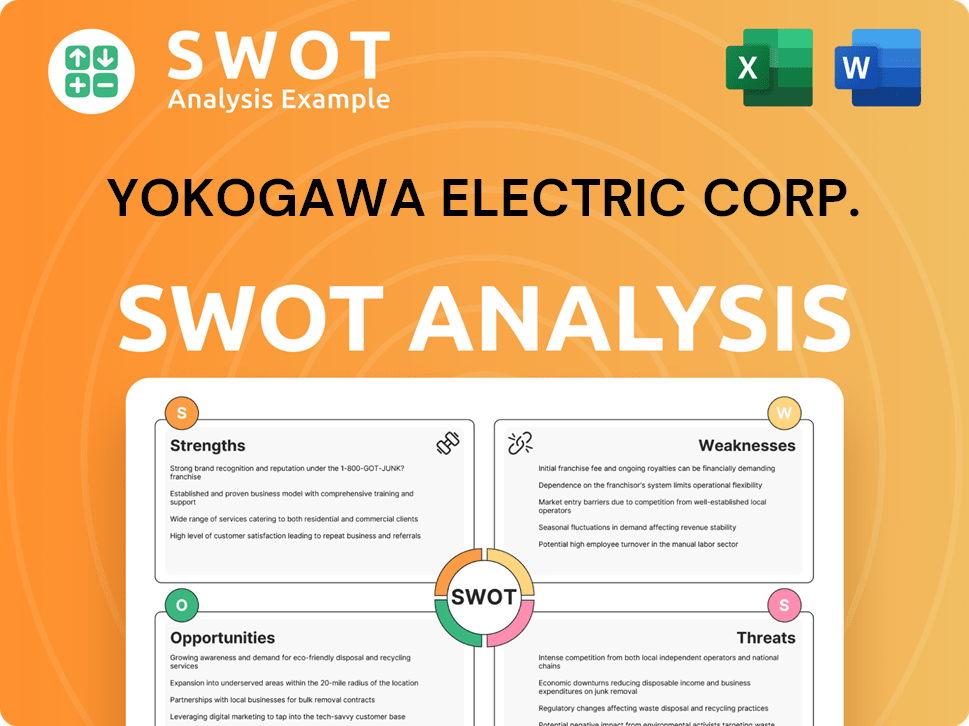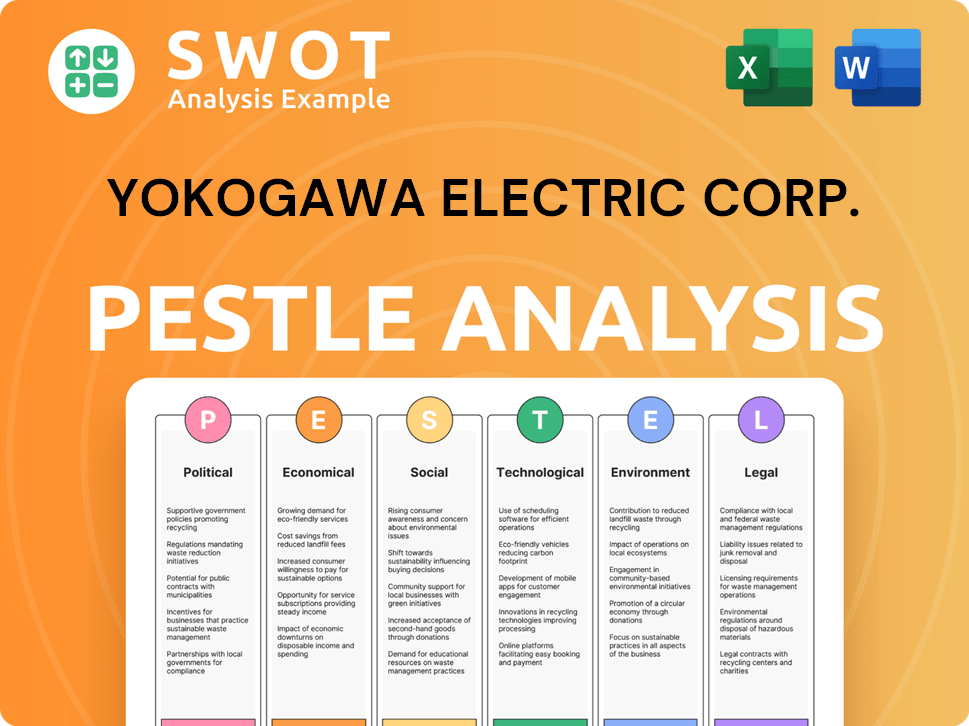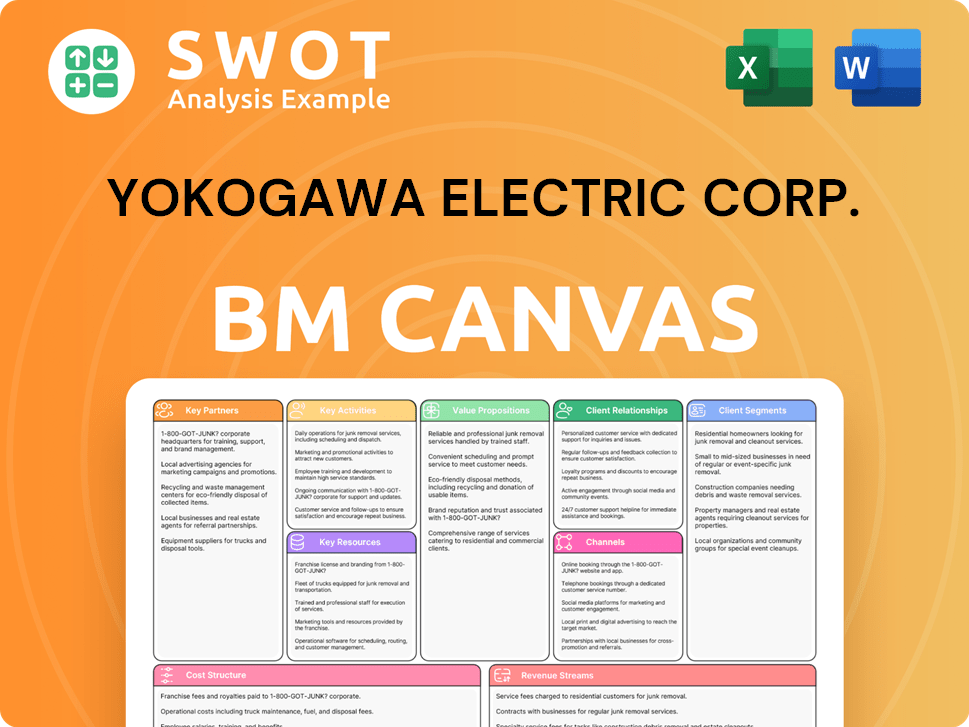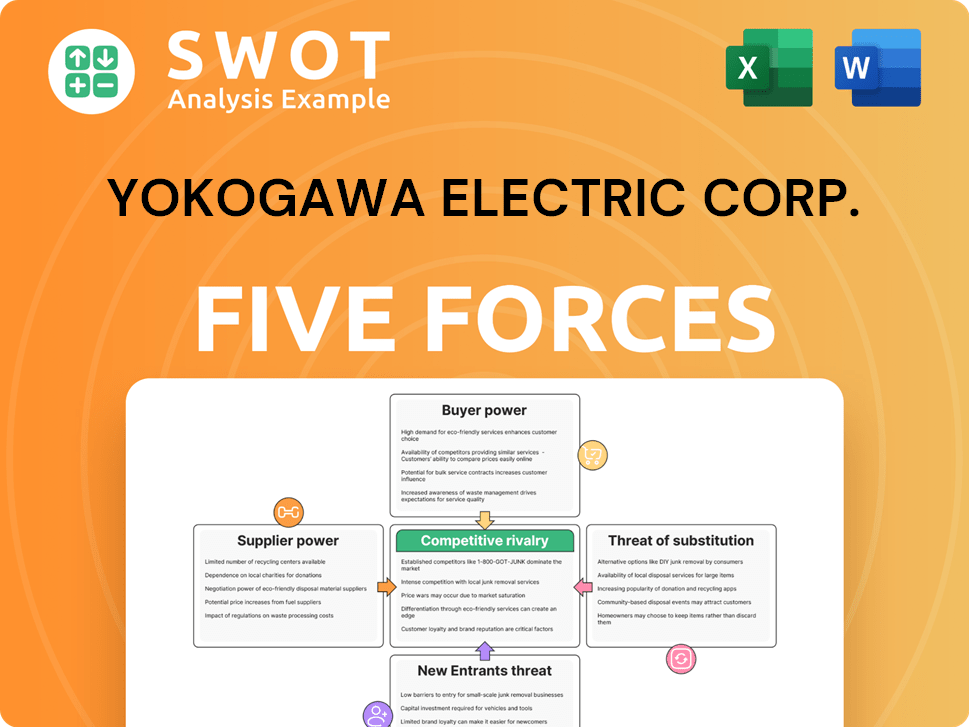Yokogawa Electric Corp. Bundle
How has Yokogawa Electric Corp. shaped the landscape of industrial automation?
Explore the remarkable journey of Yokogawa Electric Corp., a Japanese company that has been at the forefront of technological innovation for over a century. From its humble beginnings as an electric meter research institute to its current status as a global leader, Yokogawa's story is one of continuous evolution and impactful contributions. Discover the key milestones that have defined Yokogawa Electric Corp. SWOT Analysis and its enduring influence on the world of industrial automation.

This deep dive into the Yokogawa history will uncover the significant technological advancements and strategic decisions that propelled the company to its current position. Learn about Yokogawa's founding year, its early innovations in measurement solutions, and its expansion across the globe. Understanding Yokogawa Electric Corp's timeline provides valuable insights for investors and industry professionals alike, offering a glimpse into the future of industrial automation.
What is the Yokogawa Electric Corp. Founding Story?
The genesis of Yokogawa Electric Corp. began on September 1, 1915. Dr. Tamisuke Yokogawa, a distinguished architect, established an electric meter research institute in Shibuya, Tokyo. This marked the inception of a Japanese company that would become a global leader in industrial automation and measurement solutions.
Joining Dr. Yokogawa were Ichiro Yokogawa and Shin Aoki. Their initial focus was on developing and producing electric meters within Japan. This was a crucial step toward domestic production in a field that was then largely reliant on imports.
In 1920, the institute was formally incorporated as Yokogawa Electric Works Ltd. This transition solidified the company's commitment to contributing to society through measurement and control technologies. The early 20th century in Japan saw a push toward industrialization, creating a favorable environment for a company focused on electrical engineering and instrumentation. You can find more about the competitive landscape of this company in this article: Competitors Landscape of Yokogawa Electric Corp.
Yokogawa's early years were marked by innovation in electric meters, laying the foundation for its future in industrial automation.
- 1915: Founding of the electric meter research institute.
- 1920: Incorporation as Yokogawa Electric Works Ltd.
- Early focus on domestic production of electric meters.
- Vision to contribute to society through measurement and control technologies.
Yokogawa Electric Corp. SWOT Analysis
- Complete SWOT Breakdown
- Fully Customizable
- Editable in Excel & Word
- Professional Formatting
- Investor-Ready Format

What Drove the Early Growth of Yokogawa Electric Corp.?
Following its 1920 incorporation as Yokogawa Electric Works Ltd., the Yokogawa Electric Corp embarked on a path of sustained growth. Early expansion in 1933 included aircraft instruments and controllers, broadening its product range beyond electric meters. This strategic move set the stage for future innovations and its role in the industrial automation sector.
In 1933, the Japanese company expanded into aircraft instruments and controllers. This diversification marked a significant step beyond its initial focus on electric meters. The move into new product categories demonstrated a proactive approach to market opportunities, setting a precedent for future innovation.
After World War II, the Yokogawa history continued with going public in 1948. The 1950s saw the development of Japan's first electronic recorder in 1950. International collaborations, like the 1955 agreement with Foxboro, enhanced its global presence.
The 1960s saw an entry into the industrial analyzer market in 1964. The introduction of vortex flowmeters in 1969 further expanded the product line. International expansion continued with the establishment of manufacturing and sales offices in Singapore and Europe in 1974.
The company's early growth demonstrates a clear vision for sustained expansion. The consistent entry into new geographical and product markets highlights the company's strategic foresight. This proactive approach has been a key factor in establishing Yokogawa's global presence and its leadership in measurement solutions.
Yokogawa Electric Corp. PESTLE Analysis
- Covers All 6 PESTLE Categories
- No Research Needed – Save Hours of Work
- Built by Experts, Trusted by Consultants
- Instant Download, Ready to Use
- 100% Editable, Fully Customizable

What are the key Milestones in Yokogawa Electric Corp. history?
The Yokogawa Electric Corp, a prominent Japanese company, has a rich Yokogawa history marked by significant achievements and strategic shifts. From its inception, Yokogawa Electric Corp has consistently evolved, responding to market demands and technological advancements to solidify its position in the global market. This journey showcases the company's adaptability and its commitment to innovation in industrial automation and measurement solutions.
| Year | Milestone |
|---|---|
| 1975 | Released CENTUM, the world's first distributed process control system (DCS). |
| 1983 | Merged with Hokushin Electric Works, Ltd., forming Yokogawa Hokushin Electric Corp. |
| 1986 | Officially changed its name to Yokogawa Electric Corporation. |
| 1990 | Established Yokogawa Middle East E.C. in Bahrain, expanding its global footprint. |
| 1996 | Entered the biotechnology business with the release of a confocal scanner. |
| 2002 | Acquired Ando Electric, strengthening its position in test and measurement. |
| 2025 | Acquired Web Synergies to enhance digital transformation (DX) capabilities. |
| 2025 | Partnered with Dragos Inc. to enhance cybersecurity for industrial systems. |
Yokogawa Electric Corp has consistently pushed boundaries with its innovations. A pivotal innovation was the introduction of CENTUM in 1975, which revolutionized process control systems. This system's success, with approximately 16,000 projects in over 75 countries, highlights Yokogawa's early contributions to automation.
The launch of CENTUM in 1975 marked a significant advancement in process control technology. It established Yokogawa as a leader in the development of distributed control systems.
In 1988, Yokogawa expanded its portfolio by entering the high-frequency measuring instrument business. This expansion broadened the company's technological capabilities.
In 1996, Yokogawa introduced a confocal scanner, signaling its entry into the biotechnology sector. This innovation demonstrated the company's diversification strategy.
The acquisition of Web Synergies in April 2025 enhanced Yokogawa's digital transformation capabilities. This move supports the company's focus on cloud services and IT/OT security solutions.
The partnership with Dragos Inc. in January 2025 aimed to improve cybersecurity for industrial systems globally. This partnership addresses the growing need for robust security in industrial environments.
Yokogawa's global expansion, including establishing a presence in the Middle East, demonstrates its commitment to serving international markets. This strategy supports its long-term growth objectives.
Yokogawa has faced various challenges, including market fluctuations and competitive pressures. The company has responded by adapting its strategies and expanding its global presence. For more insights, see Revenue Streams & Business Model of Yokogawa Electric Corp.
Yokogawa has navigated economic downturns by adjusting its business strategies. These adjustments help maintain its market position and financial stability.
The company faces competition from other major players in the industry. Yokogawa addresses these threats through continuous innovation and strategic acquisitions.
Rapid technological changes require Yokogawa to invest in research and development. These investments ensure its products remain competitive and relevant.
Integrating acquired companies, such as Ando Electric, can present challenges. Yokogawa focuses on seamless integration to leverage new capabilities.
The increasing threat of cyberattacks on industrial systems poses a significant challenge. Yokogawa's partnership with Dragos Inc. is a proactive step to mitigate these risks.
Global economic conditions can impact Yokogawa's performance. The company adapts by diversifying its markets and optimizing its operations.
Yokogawa Electric Corp. Business Model Canvas
- Complete 9-Block Business Model Canvas
- Effortlessly Communicate Your Business Strategy
- Investor-Ready BMC Format
- 100% Editable and Customizable
- Clear and Structured Layout

What is the Timeline of Key Events for Yokogawa Electric Corp.?
Tracing the Owners & Shareholders of Yokogawa Electric Corp., the company's journey began in 1915 with the establishment of an electric meter research institute, evolving into a global leader in industrial automation. The Japanese company has consistently innovated, from developing Japan's first electronic recorder to pioneering the distributed process control system, CENTUM. Through strategic acquisitions and a forward-thinking business plan, Yokogawa Electric Corp. continues to adapt and expand its influence in the industrial automation and measurement solutions sectors.
| Year | Key Event |
|---|---|
| 1915 | Dr. Tamisuke Yokogawa established an electric meter research institute in Shibuya, Tokyo. |
| 1920 | The institute was incorporated as Yokogawa Electric Works Ltd. |
| 1933 | Began research and manufacture of aircraft instruments and flow, temperature, and pressure controllers. |
| 1950 | Developed Japan's first electronic recorder. |
| 1957 | Established Yokogawa Electric Works, Inc. as its North American sales office in New York. |
| 1964 | Made a full-scale entry into the industrial analyzer market. |
| 1975 | Released CENTUM, the world's first distributed process control system (DCS). |
| 1983 | Merged with Hokushin Electric Works, Ltd., forming Yokogawa Hokushin Electric Corp. |
| 1986 | Company name changed to Yokogawa Electric Corporation. |
| 1990 | Established Yokogawa Middle East E.C. in Bahrain. |
| 2002 | Acquired Ando Electric, expanding its test and measurement business. |
| 2016 | Acquired KBC Advanced Technologies plc, enhancing its consulting and software solutions. |
| 2024 (May) | Announced 'Growth for Sustainability 2028' medium-term business plan. |
| 2024 (June) | Acquired BaxEnergy, a plant management software provider for renewable energy. |
| 2025 (April) | Finalized agreement to acquire Web Synergies, strengthening its digital transformation (DX) capabilities. |
| 2025 (May) | Released the next-generation Release 7.01 of the CENTUM VP integrated production control system, coinciding with the 50th anniversary of the CENTUM series. |
Yokogawa's 'Growth for Sustainability 2028' plan focuses on addressing global issues through core technologies. The company anticipates continued demand in process automation, particularly driven by environmental regulations and new LNG projects.
For FY2025, Yokogawa projects a slight decrease in net sales to ¥560.0 billion and operating profit to ¥80.0 billion, due to foreign exchange impacts. However, excluding these, sales and operating income are expected to increase. The company also forecasts an increased dividend, with ¥64 for FY2025.
The acquisition of Web Synergies and partnerships in cybersecurity highlight Yokogawa's commitment to digital transformation. These initiatives are crucial for navigating the evolving industrial landscape and achieving its vision of co-innovating for a brighter future.
Yokogawa's focus on industrial automation and measurement solutions, combined with strategic acquisitions and a strong financial outlook, positions it well for sustained growth. The company's history of innovation and its current strategic initiatives reinforce its role in the industry.
Yokogawa Electric Corp. Porter's Five Forces Analysis
- Covers All 5 Competitive Forces in Detail
- Structured for Consultants, Students, and Founders
- 100% Editable in Microsoft Word & Excel
- Instant Digital Download – Use Immediately
- Compatible with Mac & PC – Fully Unlocked

Related Blogs
- What is Competitive Landscape of Yokogawa Electric Corp. Company?
- What is Growth Strategy and Future Prospects of Yokogawa Electric Corp. Company?
- How Does Yokogawa Electric Corp. Company Work?
- What is Sales and Marketing Strategy of Yokogawa Electric Corp. Company?
- What is Brief History of Yokogawa Electric Corp. Company?
- Who Owns Yokogawa Electric Corp. Company?
- What is Customer Demographics and Target Market of Yokogawa Electric Corp. Company?
Disclaimer
All information, articles, and product details provided on this website are for general informational and educational purposes only. We do not claim any ownership over, nor do we intend to infringe upon, any trademarks, copyrights, logos, brand names, or other intellectual property mentioned or depicted on this site. Such intellectual property remains the property of its respective owners, and any references here are made solely for identification or informational purposes, without implying any affiliation, endorsement, or partnership.
We make no representations or warranties, express or implied, regarding the accuracy, completeness, or suitability of any content or products presented. Nothing on this website should be construed as legal, tax, investment, financial, medical, or other professional advice. In addition, no part of this site—including articles or product references—constitutes a solicitation, recommendation, endorsement, advertisement, or offer to buy or sell any securities, franchises, or other financial instruments, particularly in jurisdictions where such activity would be unlawful.
All content is of a general nature and may not address the specific circumstances of any individual or entity. It is not a substitute for professional advice or services. Any actions you take based on the information provided here are strictly at your own risk. You accept full responsibility for any decisions or outcomes arising from your use of this website and agree to release us from any liability in connection with your use of, or reliance upon, the content or products found herein.